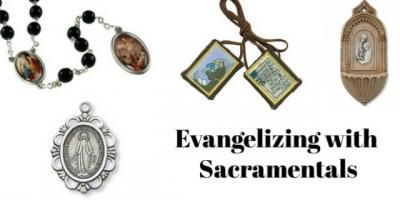Sacramentals are a part of most Catholics’ prayer lives. Before we jump to how to evangelize with sacramentals, we need to understand what they are. A quick review on the difference between sacraments and sacramentals...
Sacraments
Sacraments are actions of the Holy Spirit at work in the Church (CCC 1116). These actions are a visible symbol of invisible reality, signs that communicate the grace they signify (CCC 1127). God speaks to us through his visible creation and is incarnate (made flesh) in the visible world.
Christ used physical signs and symbolic gestures as a visual means to help those he was healing understand the invisible reality. He used spit and clay to heal the man born blind (John 9:1-12), healed the deaf man by placing his finger in his ear, spitting and touching his tongue (Mark 7:31-37) and by spitting on the blind man’s eyes and laying his hands on him (Mark 8:22-26).
God, who created us body and soul, communicates his truth to us not only through ideas and words, but through sensible signs as well.
Sacramentals
Sacramentals, on the other hand are objects intended to strengthen our faith by reminding us of God’s presence in our lives and calling us to prayer. They are different than the sacraments in that they are instituted by the Church versus sacraments which originate in Christ.
Sacramentals can be objects, such as holy water, medals, rosaries, or ashes; or they can be actions (for example, a pilgrimage); or they can be words (such as a blessing). In countless ways, these sacred visual images and words provide us opportunities to cooperate with the working of God’s grace. (Regis J. Flaherty) [1]
The blessing of the object pours out God’s blessings upon us through Christ and his death and resurrection. They prepare for and extend the grace of the sacraments by virtue of the intercession of the Church because they make present the intercession of the entire Church.
The sacramental is actually the blessing prayed over the object, not the object itself. Sacramentals are not magic! The blessing prayed over them helps us strengthen our faith when we use them in popular devotions or expressions of popular piety. [2]
TL;DR:
sacramental (small 's') = tools for living daily sanctity.
Sacramental (big 'S') = pertains to properties or qualities belonging to the Church’s Seven Sacraments
How to Evangelize with Sacramentals
A great example of how a sacramental can work is expressed in a story by Regina Doman in the June 1996 issue of "New Covenant" magazine:
Friends who were Mennonites came to dinner at Regina’s home. The children were quite amazed at the Divine Mercy image, the icons hanging in the bedroom, the Mary night light in the hallway and the Our Lady of Guadalupe picture that hung in the entryway.
Later that evening they came upon the 5 year old boy "gazing in distress at the large realistic crucifix on the wall. 'Look. He's hurt,’ their 5-year-old boy said, with a worried look on his face.
'That's Jesus,' his mother said. 'Remember how I told you that Jesus suffered on the cross for your sins? That's because He loves you so much.'
"As the child stared at the terrible wounds of the Man on the cross, the expression on his face turned from horror to awe. It was obvious to both of us that the teaching of his Christian parents had come home to his heart in a new way.” [3]
Children aren't the only ones impacted by the presence of these sacramentals. They can help all of us - adults and children alike - incarnate the faith more deeply.
I carry a St. Benedict medal in my pocket and during my rush to get to my next flight and juggling things around in my pockets and briefcase I dropped it without knowing it. A young man ran up to me, “Sir! You dropped this!” After thanking him sincerely he asked, “Sir, may I ask what that is?”
I explained to him “Well, I’m a Christian and I have committed myself to live a Christian life at all times. That medal reminds me that there are many temptations in the world that will try to draw me away from that commitment and Christ will help me avoid them if I turn to him when I’m tempted.” He said, “that’s cool! Have a great day!”
My comment didn’t cause him to have a major conversion experience on the spot, but it did make him think about how Christ acts in a Christians everyday life.
 Other ways sacramentals can be used to evangelize:
Other ways sacramentals can be used to evangelize:
- Giving holy cards or saint medals for a patron saint with particular meaning when praying for someone (i.e. a St. Peregrine medal for someone who in cancer treatment or an Our Lady of Sorrows holy card for someone who is suffering).
- Placing holy water fonts near doorways in your home and blessing with them as you leave and arrive.
- Rosary and other prayer bracelets and rings to help remind yourself to pray the rosary throughout the day.
- Praying with sacred art - a kind of visio divina
- Inviting children to focus on an image or a crucifix when praying can help them to move beyond rote, memorized prayers and encourage them to talk to Jesus (and Mary) like they would a friend. Read more about Praying with Children.
- Blessing your home with blessed chalk
Use and display your sacramentals publicly and proudly. Remember that they aren't magic (and we are not superstitious).
Always Be Mindful of Your Story
The most important element of evangelizing using sacramentals is to think about the sacramentals you use and pray about why you use them. How do they help you grow in your own personal and communal relationship with Jesus and His Church?
All authentic evangelization starts with your own relationship with Jesus and your faith journey. Sharing how sacramentals have helped you on your journey will be the more fruitful than Catechism quotes or quasi-superstitious traditions when answering someone who asks what they are or why you use them.


